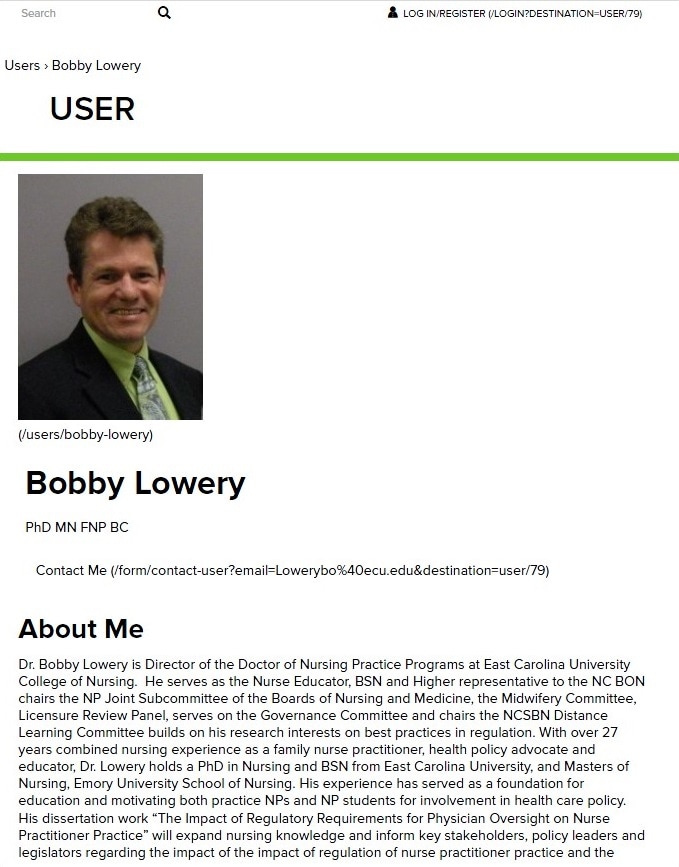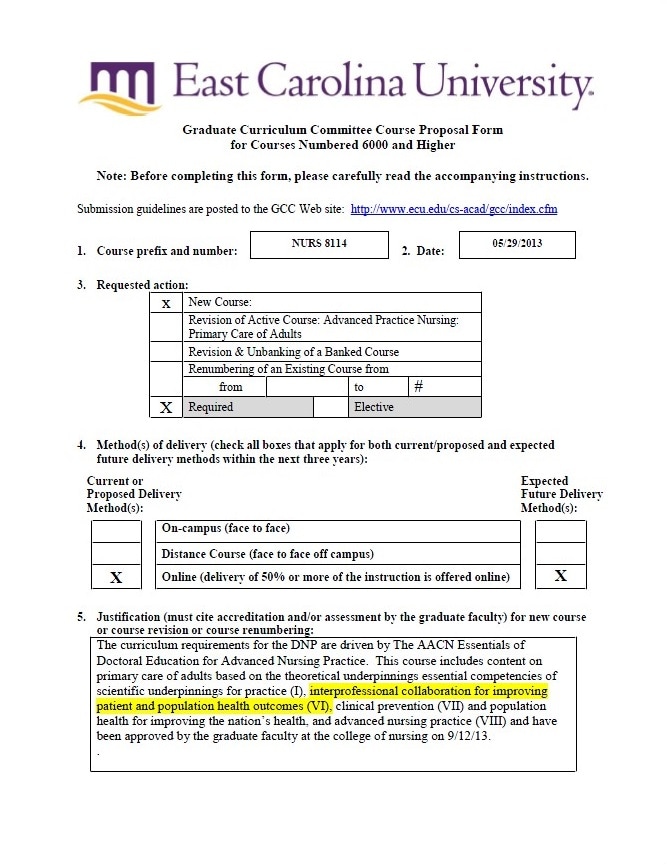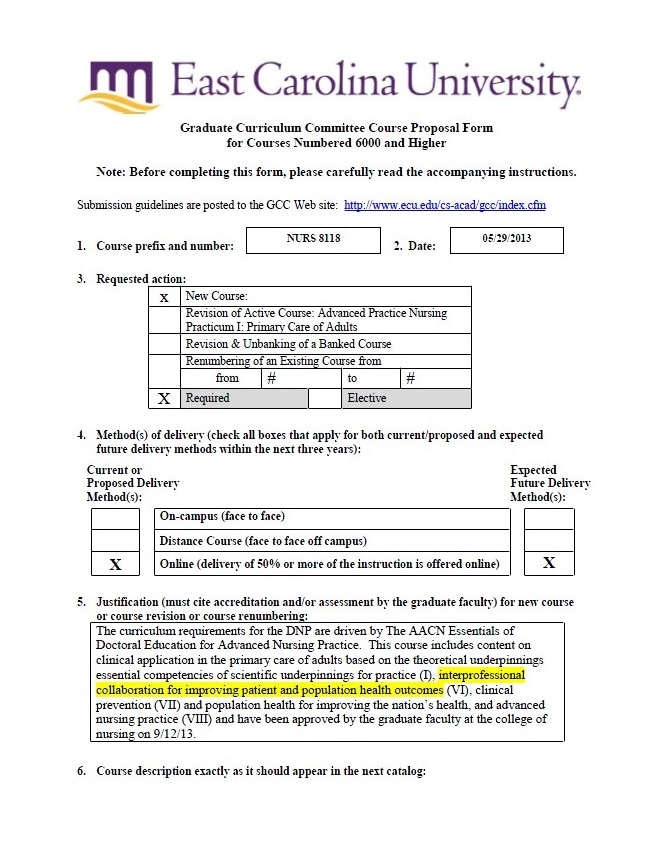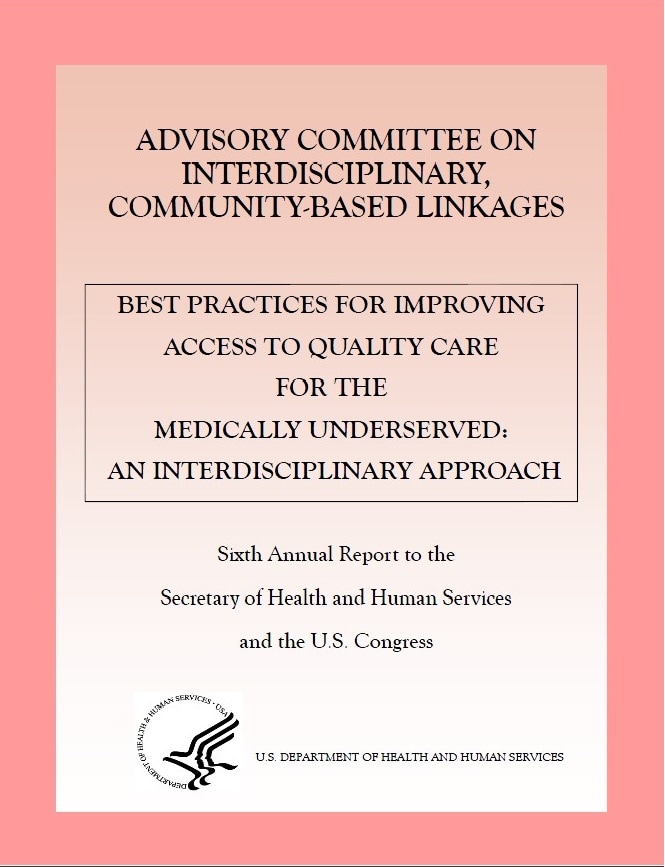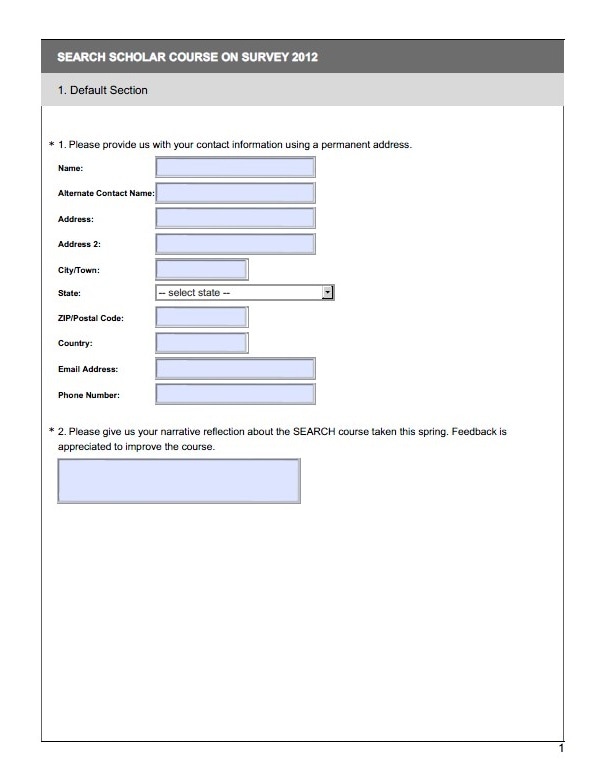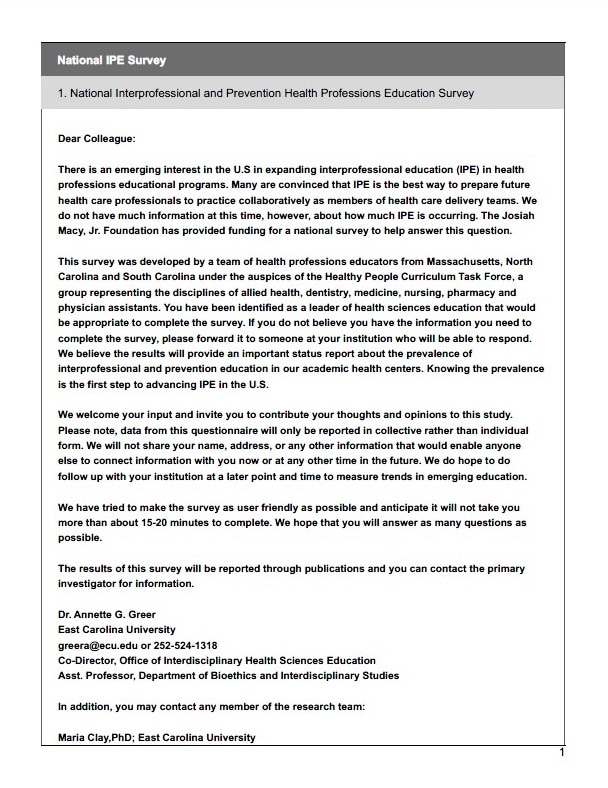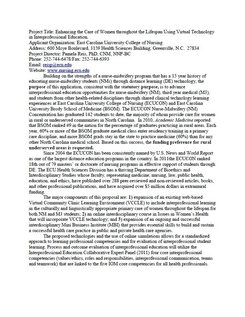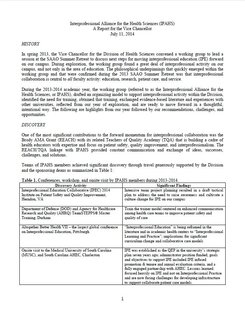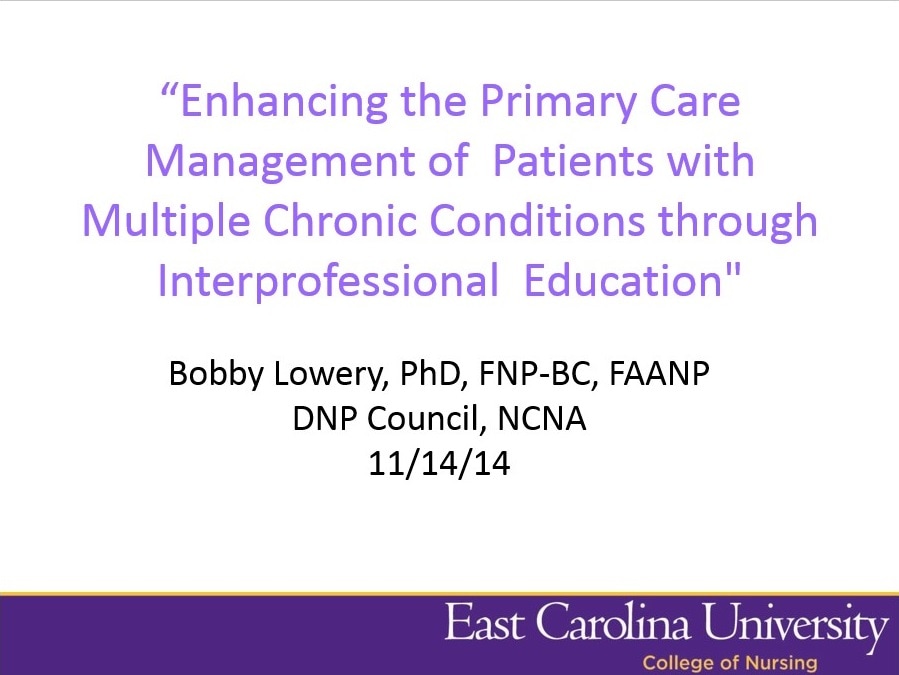Interprofessional Prevention Education Program at East Carolina University has a long history dating back to 1994 when the Interdisciplinary Rural Health Training Program later known as the Quentin Burdick Grant was first awarded from the Bureau of Health Professions through the Health Services Resources Administration. The programs included undergraduate and graduate courses, Duke Endowment Funding, Gold Leaf Funding, and continued HRSA Bureau of Health Professions funding through 2005. The APTR Institute funding became a bridge to engage new faculty and partners in SEARCH funding for re-engineering and fostering of disciplinary expansion for both online and clinical services in rural underserved communities through 2012. Consequently, resultant grants from interested faculty included start-up funding for the IHI from roll-over funding from SEARCH, a midwifery HRSA grant designed to develop curriculum material for nurses and medical students, a Doctorate of Nurse Practice HRSA grant for health sciences learners focused on prevention, rural issues (including agromedicine), and case based simulations, and IHI Open Schools. Each of these projects have built on the other and added educational resources to the health sciences curriculum and campus. In addition, faculty attending the APTR IPPE Institute collaborated with national leaders to develop a National IPPE Assessment and Planning Instrument that has been used widely on a national and international basis. Further, a subset of the question stems have been used for a national benchmarking study that was replicated during 2015. East Carolina University has also created a Task Force that resulted in a senior level leadership role for interprofessional activities: Associate Vice Chancellor.
IMPACT
|
IPE courses benefit 200 undergraduates and 50 Doctor of Nursing (DNP) Practice students each year. Over 7 million in funding for IPE initiatives over the past 10 years. |
Strengthened partnerships with County and Local Health Departments, Community Health Agencies, and local Churches. |
aptr project proposal for 2007/2008 ipe institute
Health care students were to be trained to work as a clinical consulting team to promote physical fitness in adolescents. This educational project was to be implemented within the framework of an existing course, “The Clinical Consulting Team,” which prepares health care professionals to work as a team of clinical consultants within rural environments.
Final Report in 2008
Title for the IPE prevention initiative
East Carolina University and Greene County Health Care, Inc. Interprofessional Prevention Education (AKA “The Health Care Consulting Team”)
Strategic Direction and Goals
Strategic Direction: East Carolina University and Greene County Health Care, Inc. (initially public health, nursing, pharmacy, and allied health) continue to collaborate to train health care students to work as a clinical consulting team with the goal of promoting healthy lifestyle behaviors in rural adolescents. This educational project was implemented within the framework of an existing course, “The Clinical Consulting Team” (IRHE 6100) and was set to be offered again in Spring 2009.
Goals of the “The Health Care Consulting Team” project:
Objectives of the “The Health Care Consulting Team” project:
Student Learning Outcomes: At the completion of the spring 2007 academic session, the students were able to collaborate with others as a member of an interprofessional health care team to:
Format: Program was offered as a semester long course for academic credit using online technology that linked the faculty, students, and community members.
Partners
Greene County Health Care, Inc.
Snow Hill, NC
The mission of Greene County Health Care, Inc. is to provide health care to all residents of Greene County, North Carolina and the surrounding area with an emphasis on providing services to the underserved. Healthcare services for children are available in schools for the county. Services offered through the school-based clinic offers a comprehensive array of services. Services include: medical care, preventive health services, mental health assessment and treatment, chronic disease management, laboratory testing, health education and promotion, social service, nutritional services, and other specialty services, such as dental care and well-baby care for students with children.
Student Participants: Seventeen students drawn from allied health, nursing, public health, human ecology educational programs participated in the course. These students functioned in several interprofessional teams centered around selected prioritized needs.
Title for the IPE prevention initiative
East Carolina University and Greene County Health Care, Inc. Interprofessional Prevention Education (AKA “The Health Care Consulting Team”)
Strategic Direction and Goals
Strategic Direction: East Carolina University and Greene County Health Care, Inc. (initially public health, nursing, pharmacy, and allied health) continue to collaborate to train health care students to work as a clinical consulting team with the goal of promoting healthy lifestyle behaviors in rural adolescents. This educational project was implemented within the framework of an existing course, “The Clinical Consulting Team” (IRHE 6100) and was set to be offered again in Spring 2009.
Goals of the “The Health Care Consulting Team” project:
- Help the community identify key adolescent health prevention interventions, then help the community conduct these interventions in a phase II class;
- Train students from a variety of disciplines to provide consultation services as an interdisciplinary team.
Objectives of the “The Health Care Consulting Team” project:
- Teach health science students from a variety of disciplines:
- Effective team skills
- Consulting process
- Content relative to health assessment and prevention
- Affect positive health behaviors in middle school and/or high school students in rural eastern NC community by assisting Greene County Health Care, Inc in prioritized programming.
Student Learning Outcomes: At the completion of the spring 2007 academic session, the students were able to collaborate with others as a member of an interprofessional health care team to:
- Assess the health status of adolescent individuals in rural middle and high school;
- Provide peer education on strategies for prioritized programming interventions to the community;
- Develop comprehensive, interprofessional health logic models that addressed prioritized adolescent needs
- Communicate effectively with the community in negotiating recommendations for programming; and
- Conduct follow-up consultations to the community including a final report.
Format: Program was offered as a semester long course for academic credit using online technology that linked the faculty, students, and community members.
Partners
Greene County Health Care, Inc.
Snow Hill, NC
The mission of Greene County Health Care, Inc. is to provide health care to all residents of Greene County, North Carolina and the surrounding area with an emphasis on providing services to the underserved. Healthcare services for children are available in schools for the county. Services offered through the school-based clinic offers a comprehensive array of services. Services include: medical care, preventive health services, mental health assessment and treatment, chronic disease management, laboratory testing, health education and promotion, social service, nutritional services, and other specialty services, such as dental care and well-baby care for students with children.
Student Participants: Seventeen students drawn from allied health, nursing, public health, human ecology educational programs participated in the course. These students functioned in several interprofessional teams centered around selected prioritized needs.
current ipe activity/project description
The impetus for IPE at East Carolina University were the Rural Health Training Program and Quentin Burdick Grants (see attached). It was the APTR/CDC support that bridged the gap when funding ended from Title Vii to allow for continuation and development of a sustainable means for IPE course development online with a component in the community for students at the graduate / professional level.
Structural Dimensions:
The structural frame for IPE at East Carolina University was provided through the creation of the Office of Interdisciplinary Health Sciences Education (OIHSE) in existence from 1999-2015. The issue for this office initially was a lack of institutional funding as the source for funding was grant based through Quentin Burdick. Funding for one position to teach courses designed for pre-health professional concentrations was established in 2005. However, organizational change in leadership at various administrative levels meant the program was not supported until the APTR/CDC and SEARCH grants provided a functional means for interprofessional collaboration of graduate / professional level course development. The Office of Interdisciplinary Health Sciences became a resource to other academic units in the form of consultation and community partnership development for additional grant development.
The structural frame for IPE at East Carolina University was provided through the creation of the Office of Interdisciplinary Health Sciences Education (OIHSE) in existence from 1999-2015. The issue for this office initially was a lack of institutional funding as the source for funding was grant based through Quentin Burdick. Funding for one position to teach courses designed for pre-health professional concentrations was established in 2005. However, organizational change in leadership at various administrative levels meant the program was not supported until the APTR/CDC and SEARCH grants provided a functional means for interprofessional collaboration of graduate / professional level course development. The Office of Interdisciplinary Health Sciences became a resource to other academic units in the form of consultation and community partnership development for additional grant development.
Human Dimensions:
APTR IPE served as a faculty development for a group of new faculty not previously exposed to IPE training and allowed them to share with their units. The SEARCH grant brought even greater attention to IPE faculty engagement and presentations to units for recruitment of student participation. It helped that the initial Quentin Burdick faculty innovators were now in positions of administration to garner support to language placed in strategic planning documents. The APTR and SEARCH grants provided funding supplements to the student participants and to community partners. Certificates from East AHEC were provided to IPE program completers and increased regional goodwill through student projects.
APTR IPE served as a faculty development for a group of new faculty not previously exposed to IPE training and allowed them to share with their units. The SEARCH grant brought even greater attention to IPE faculty engagement and presentations to units for recruitment of student participation. It helped that the initial Quentin Burdick faculty innovators were now in positions of administration to garner support to language placed in strategic planning documents. The APTR and SEARCH grants provided funding supplements to the student participants and to community partners. Certificates from East AHEC were provided to IPE program completers and increased regional goodwill through student projects.
Political Dimensions:
Funding remaining from SEARCH grant gave impetus to the IHI open school as a designation from East AHEC and pilot which resulted in an AMA grant of $1 million. Reis, a nursing faculty garnered IPE expertise from Drs. Clay and Greer (OIHSE co-directors) on her grant, resulting in a Midwifery grant of over $1 million dollars, Dr. Bobby Lowery integrated IPE and Dr. Greer into his DNP grant resulting in another $1 million dollars, Dr. Harding integrated IPE building on the work of Reis and Lowery for $2.5 million dollars, and Dr. Hodgeson used IPE as a framework for integration of family and marriage therapy services into family medicine education and received multiple grants totaling over 2 million over the last decade with the assistance of Dr. Cummings (former OIHSE co-director) and other collaborators. The influence of the OIHSE leadership and resources provided a framework for political influence and a track record of stable outcomes that provided credence to the ability of these grants to be successful. The OIHSE co-directors (Clay and Greer) served as faculty and evaluators for the APTR IPE Institutes.
Funding remaining from SEARCH grant gave impetus to the IHI open school as a designation from East AHEC and pilot which resulted in an AMA grant of $1 million. Reis, a nursing faculty garnered IPE expertise from Drs. Clay and Greer (OIHSE co-directors) on her grant, resulting in a Midwifery grant of over $1 million dollars, Dr. Bobby Lowery integrated IPE and Dr. Greer into his DNP grant resulting in another $1 million dollars, Dr. Harding integrated IPE building on the work of Reis and Lowery for $2.5 million dollars, and Dr. Hodgeson used IPE as a framework for integration of family and marriage therapy services into family medicine education and received multiple grants totaling over 2 million over the last decade with the assistance of Dr. Cummings (former OIHSE co-director) and other collaborators. The influence of the OIHSE leadership and resources provided a framework for political influence and a track record of stable outcomes that provided credence to the ability of these grants to be successful. The OIHSE co-directors (Clay and Greer) served as faculty and evaluators for the APTR IPE Institutes.
Symbolic Dimensions:
The OIHSE co-directors (Clay and Greer) partnered nationally with IPE leaders (AAHC, AIHC, APTR) in other states to develop instruments for institutional assessment and planning purposes through APTR funding. The instrument has been used by multiple national and international programs for assessment and planning of IPE (see example of request). Further, Macy funded the group's national baseline assessment of IPE status at Academic Health Centers in the United States (2010 and 2015). Drs. Clay and Greer were founding board members of AIHC serving 2 and 3 year terms respectively. National and international presentations have been delivered and journal manuscripts published on the IPE work. Drs. Cummings and Greer recently published book chapters in Today’s Health Professionals: Working Together to Provide Quality Care, editor Dr. Pat Royal.
The OIHSE co-directors (Clay and Greer) partnered nationally with IPE leaders (AAHC, AIHC, APTR) in other states to develop instruments for institutional assessment and planning purposes through APTR funding. The instrument has been used by multiple national and international programs for assessment and planning of IPE (see example of request). Further, Macy funded the group's national baseline assessment of IPE status at Academic Health Centers in the United States (2010 and 2015). Drs. Clay and Greer were founding board members of AIHC serving 2 and 3 year terms respectively. National and international presentations have been delivered and journal manuscripts published on the IPE work. Drs. Cummings and Greer recently published book chapters in Today’s Health Professionals: Working Together to Provide Quality Care, editor Dr. Pat Royal.
|
IPE OFFERINGS INCLUDE:
|
PROFESSIONS/DISCIPLINES/SCHOOLS INVOLVED:
|
Do you have formal affiliation agreements with any of the schools mentioned above?
No as they are all part of a university system.
No as they are all part of a university system.
|
ACADEMIC LEVELS TARGETED:
|
PLACEMENT SITES FOR ANY SERVICE-LEARNING COMPONENTS:
|
FOR COURSES ONLY:
- Number of students enrolled in IPE course during the most recent academic year: Undergraduate (200 per year)
- Is this a shared/cross-listed course? No
- Title of Course(s): Interdisciplinary Rural Health Team Training
- Number of credits offered: 3 sh
- Number of students enrolled in IPE course during the most recent academic year: DNP approximately 50
- Is this a shared/cross-listed course? No
- Title of Course(s): NURS 8114 - Advanced Practice Nursing: Primary Care of Adults; NURS 8118 - Advanced Practice Nursing Practicum I: Primary Care of Adults
- Number or credits offered: 4 sh (NURS 8114) 3sh (NURS 8118)
EVALUATION METHODS USED FOR THE SUBGRANT PROJECT:
- Quantitative surveys
- Qualitative surveys
- Focus Groups
- Community preceptor surveys
- Faculty surveys
lessons/results/outcomes
Evaluation Results:
The APTR IPE Leadership institute prepared a host of faculty from our institution that began new champions in interprofessional education. The primary impetus for IPE at ECU had relied on long-term leadership (Cummings and Clay, 1994 – 2005). The APTR course provided a framework for the SEARCH grant. Sustained partnerships with East AHEC over the years assisted in moving the activity of IPE across the campus and the region of Eastern North Carolina and beyond into other states engagement in our SEARCH program. Members of the board for SEARCH engaged in writing their own grants to HRSA for IPE and funding from SEARCH became seed money for the AMA grant through the IHI Open School program. This began a cascade of funded IPE projects resulting in over 7 million dollars of programmatic development primarily through HRSA (2010-2016).
The APTR IPE Leadership institute prepared a host of faculty from our institution that began new champions in interprofessional education. The primary impetus for IPE at ECU had relied on long-term leadership (Cummings and Clay, 1994 – 2005). The APTR course provided a framework for the SEARCH grant. Sustained partnerships with East AHEC over the years assisted in moving the activity of IPE across the campus and the region of Eastern North Carolina and beyond into other states engagement in our SEARCH program. Members of the board for SEARCH engaged in writing their own grants to HRSA for IPE and funding from SEARCH became seed money for the AMA grant through the IHI Open School program. This began a cascade of funded IPE projects resulting in over 7 million dollars of programmatic development primarily through HRSA (2010-2016).
COMPANION/RESOURCE MATERIALS TO SHARE:
- Bobby Lowery Biography
- NURS 8114 Course Proposal
- NURS 8118 Course Proposal
- Sixth Report
- Search Scholar Course on Survey 2012
- National IPE Survey
- Other Project Information Abstract Attachments
- Interprofessional Alliance for the Health Sciences (IPAHS) - A report for the Vice Chancellor 2013-2014
- Enhancing Primary Care Management of Patients with Multiple Chronic Conditions through Interprofessional Educations



